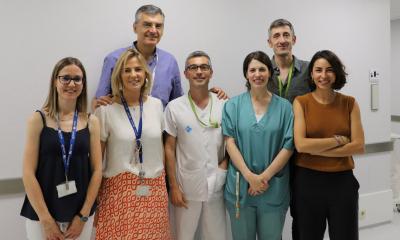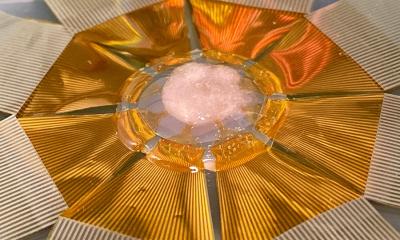Biologised medical technology
New approaches, solutions and outlooks on biologised medical technology developed in the Berlin metropolitan region were presented at this year’s annual 'Medical technology meeting place' in Berlin, which presents the latest research, new product developments and best practice examples from the greater-Berlin area.
report: Bettina Döbereiner

The rather young discipline of biologised medical technology deals with the combination of biological or pharmaceutical agents with conventional, primarily mechanical medical devices. Located at the interface of natural sciences and engineering, the field offers a stream of innovative ideas to treat diseases and for organ replacement. Thus, Professor Karl Max Einhäupl, CEO of Charité, Berlin, emphasised in his keynote speech that biologised medical technology could truly be considered one of the markets that will shape Berlin’s economic future.
A trailblazer in biologised medical technology: heparin coating
Lars Dahms, developer at Berlin Heart, explained the already classic example of the combination of biological material with a medical device: heparin coating. The use of heparin, a molecule that is naturally produced in humans and animals to reduce thrombosis, dates back to the 1960s. Today, Dahms covalently bonds the thin heparin film (Carmeda) to the smooth and flow-optimised blood contact surfaces of the pumps in Berlin Heart’s ventricular assist device (VAD) Excor Adult to offer protection against thromboembolic complications.
Polymer-free, bio-resorbable stent coating
Engineer Dr Jorge Calisse, Director of Research & Development, Vascular Systems, at B. Braun Melsungen AG, Berlin, presented a new medical device featuring a pharmacological agent.
Coroflex ISAR, developed in close cooperation with Professor Kastrati of the German Heart Centre in Munich, is a drug-eluting stent (DES) with polymer-free coating to treat complex cardiovascular stenosis. Sirolimus, an anti-inflammatory and anti-proliferative agent, is delivered via a probucol matrix. According to Dr Calisse the coating and the agent are resorbed completely within three months reducing the risk of inflammation compared to conventional DES with polymer coating. The device received the CE mark earlier this year.
Biological vascular replacement
Biologised products not only have mechanical properties supplemented by biomolecules or biological or pharmacological agents, so-called biofunctionalised products, but also bio-implants and cell implants developed and used particularly in regenerative medicine. Ernst Weigang, Medical Director at the Clinic of Vascular Surgery and Endovascular Therapy at Evangelische Krankenhaus Hubertus in Berlin presented two such products: vascular patches derived from bovine pericardium (Vascu-Guard/Synovis Surgical Innovations, USA) and a biosynthetic vascular graft that is a composite of cross-linked ovine collagen with a polyester mesh endoskeleton (Omniflow II/Bio Nova International, Australia).
However, both the bovine patches and biosynthetic vascular graft are only used in Professor Weigang’s clinic when no autologous material, such as a vein, is available. The innovative products have major advantages compared to the conventional approach, says Professor Weigang, such as a high degree of biocompatibility and good microvascularisation, which reduces the infection risk. Additionally: antibiotics are more effective. Moreover, the biosynthetic vascular grafts have proven to result in higher long-term patency and limb conservation rates than conventional alloplastic grafts.
A dream coming true? A biologically regenerated heart
Professor Christof Stamm ventured a look into the remote future of medical technology. Senior physician at the Clinic for Cardiac, Thoracic and Vascular Surgery at the German Heart Institute Berlin (DHZB) and leading researcher of the working group Myocardial Regeneration in Ischemic Heart Disease at the Berlin-Brandenburg Centre for Regenerative Therapies (BCRT), he shared his vision. One day we will be able to stimulate the heart to regenerate destroyed heart muscle tissue in vivo.
‘Today, the human body cannot sufficiently replace destroyed tissue, for example in the course of a myocardial infarction. Therefore, scientists have been trying for more than two decades to reproduce tissue, or to trigger the heart to reproduce its own tissue. So far, however, without significant clinical success.’
Professor Stamm and team try to directly reprogramme fibroblasts into cardiomyocytes – a process called transdifferentiation. While this can already be done in vitro, the scientists aim to transform fibroblasts into cardiomyocytes in the beating heart. To do so, certain genes that trigger the formation of cardiomyocytes in the maternal body are, for example with the help of viruses, implanted into the cardiac fibroblasts.
According to Stamm research results indicate that this approach works in mice. Now it remains to be seen to what extent the method and results can be reproduced in humans. For now, possible clinical studies are still a long way off.
All the sessions at the event illustrated that – despite all these innovations – biologised medical technology is a vast, uncharted territory, where inter alia basic material sciences research will find ample opportunity to map out new roads.
10.11.2014











